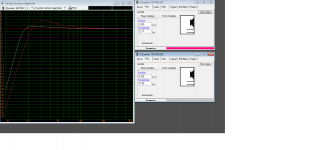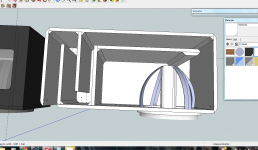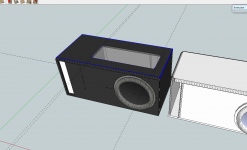Hey guys, Im going to get alot of beef on this one, but I've been reading forums for a few weeks on just about everything and really, I kinda need help with two things. I've designed a Nice ported box (I think) and I need some help to know if I'm reading things right.
Background:
I am looking for a good SQ box with an REMX15. I want it to get loud, but also have smooth transitions and not just blobby bass. I've always had cheap systems with prefab boxes or stuff that was just built to fit. I want everything to sound perfect now. Ive put alot of money into this and cant afford to pay somebody for designs- and buy parts.
The box, Ive run a ported box made from .75" mdf with a plexy window on top. 3in port thats 74.25" long total length. total volume is about 5.2ft^3 and 3.2ft^3 not including the port. Do my curves drop off right for an sq setup or is there a better curve that I want? Ive also been told that T-line is really the best, but how do i fit a 15 in a t-line without having a stupid huge box and a 12" port?
Much thanks to all help! I've done so much to get this far, I'm just tired of clicking links at this point. The outer dimensions of the box are 39x18x18. dont want to get much bigger than that
The outer dimensions of the box are 39x18x18. dont want to get much bigger than that
Background:
I am looking for a good SQ box with an REMX15. I want it to get loud, but also have smooth transitions and not just blobby bass. I've always had cheap systems with prefab boxes or stuff that was just built to fit. I want everything to sound perfect now. Ive put alot of money into this and cant afford to pay somebody for designs- and buy parts.
The box, Ive run a ported box made from .75" mdf with a plexy window on top. 3in port thats 74.25" long total length. total volume is about 5.2ft^3 and 3.2ft^3 not including the port. Do my curves drop off right for an sq setup or is there a better curve that I want? Ive also been told that T-line is really the best, but how do i fit a 15 in a t-line without having a stupid huge box and a 12" port?
Much thanks to all help! I've done so much to get this far, I'm just tired of clicking links at this point.
Attachments
For use in a car, I'd consider building the biggest sealed cabinet you can.
Cabin gain in a car means you get more boost as you go lower in frequency, so if you tune a box in WinISD to be flat to 20Hz, you'll find (once its in the car) its much louder at 20Hz than higher up.
A big sealed box will roll off quite slowly, so, once you've put it in the car, you'll get a flatter bass response.
Also, 18mm MDF is not going to be enough for this driver (if it is the 15" long-throw beastie I think it is). I'd say double that as a minimum, and make sure you brace it well - you don't want the cabinet to vibrate.
Transmission lines often sound "clean" (or whatever) because the cabinet layout inherently braces the cabinet.
A well-made sealed cabinet will be able to match it in sound quality, though might not go quite as loud (shouldn't be a problem with that driver and plenty of power).
HTH
Chris
Cabin gain in a car means you get more boost as you go lower in frequency, so if you tune a box in WinISD to be flat to 20Hz, you'll find (once its in the car) its much louder at 20Hz than higher up.
A big sealed box will roll off quite slowly, so, once you've put it in the car, you'll get a flatter bass response.
Also, 18mm MDF is not going to be enough for this driver (if it is the 15" long-throw beastie I think it is). I'd say double that as a minimum, and make sure you brace it well - you don't want the cabinet to vibrate.
Transmission lines often sound "clean" (or whatever) because the cabinet layout inherently braces the cabinet.
A well-made sealed cabinet will be able to match it in sound quality, though might not go quite as loud (shouldn't be a problem with that driver and plenty of power).
HTH
Chris
Yea, this baby is a little beast  . Its going to be in an suv (4runner) so theres alot of outer air space. the front is the only part that I have doubled up (1.5" total of mdf) so More braces will have to come. So, with the fact that its not hiding in a trunk, what do you have to say for the design?
. Its going to be in an suv (4runner) so theres alot of outer air space. the front is the only part that I have doubled up (1.5" total of mdf) so More braces will have to come. So, with the fact that its not hiding in a trunk, what do you have to say for the design?
Aright, thanks!
any recommendations on how I should eq the box in its surroundings? 25mm MDF shouldnt be too much more expensive, Ill have to figure something out for bracing though. I planned on having a plexy window and I need something that wouldnt be an eye sore when looking into the box...
any recommendations on how I should eq the box in its surroundings? 25mm MDF shouldnt be too much more expensive, Ill have to figure something out for bracing though. I planned on having a plexy window and I need something that wouldnt be an eye sore when looking into the box...
I'd start out simple using a capacitor inline with the signal input of the amplifier.
That'll reduce the level of the lower bass, (hopefully) giving a more balanced bass response.
You'll need to know the input impedance of the amp - this can be measured easily enough - just plug a lead in and measure the resistance between the contacts.
Plug the numbers in here:
Passive Crossovers, Capacitor and Coil Calculator
I'd advise picking ~50Hz as a starting value - buy a few caps of different values, and play around 'til it sounds right.
The only way to tell if you need the cap is to listen - you might prefer the extra output right at the bottom end (makes it sound very powerful, even at lower volumes). It might not be exactly how the recording engineer intended, but if it sounds good to you, I can't argue with that.
Chris
That'll reduce the level of the lower bass, (hopefully) giving a more balanced bass response.
You'll need to know the input impedance of the amp - this can be measured easily enough - just plug a lead in and measure the resistance between the contacts.
Plug the numbers in here:
Passive Crossovers, Capacitor and Coil Calculator
I'd advise picking ~50Hz as a starting value - buy a few caps of different values, and play around 'til it sounds right.
The only way to tell if you need the cap is to listen - you might prefer the extra output right at the bottom end (makes it sound very powerful, even at lower volumes). It might not be exactly how the recording engineer intended, but if it sounds good to you, I can't argue with that.
Chris
You'll need to know the input impedance of the amp - this can be measured easily enough - just plug a lead in and measure the resistance between the contacts.
That will give an incorrect due to the DC blocking cap present inside the amp. To measure input impedance you need a signal generator (PC with sound card) and variable resistor in series with the amp input. When the voltage measured across the amp input is exactly half that of the signal generator output, whip out the variable resistor and measure its resistance. The value is equal to the amp input impedance.
- Status
- This old topic is closed. If you want to reopen this topic, contact a moderator using the "Report Post" button.
- Home
- Loudspeakers
- Subwoofers
- Box Design help and should I consider T-line?


